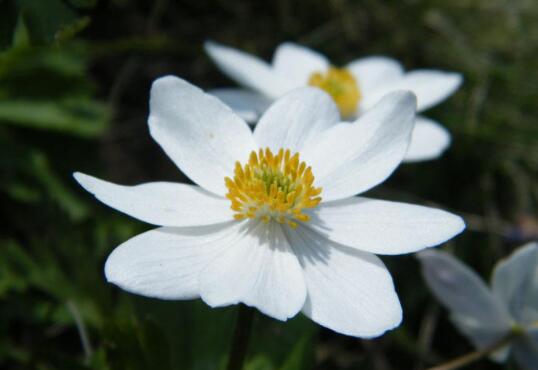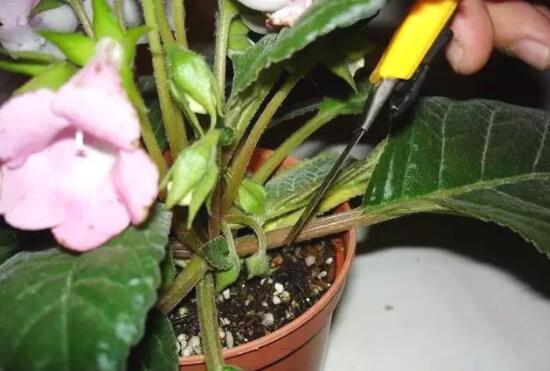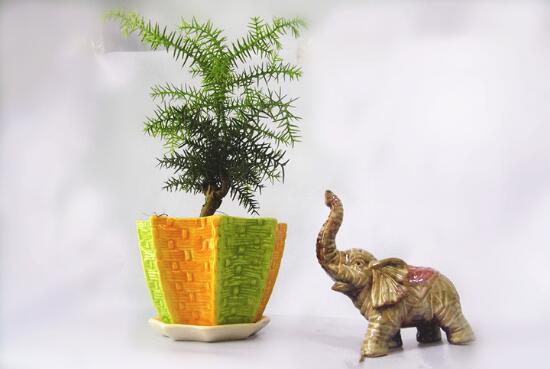How to raise anemone, breeding methods and precautions / diligent fertilization of anemone
Anemone is the national flower of the Asian country Israel, which is highly sought after locally, and it can often be seen in all parts of our country, but it is not easy to raise it well, and there are many places that need to be paid attention to. About how to raise anemones? What are the breeding methods and matters needing attention of anemone? Next, the editor will take you to learn about it.
First, how to raise anemones and understand their habits

If we want to know how to raise anemone, we must first understand the growth habits of this plant, which is cool, moist, sunny, cold-resistant, high-temperature and humid, so we must keep the environment ventilated in summer. and often spray water to the plant, once to reduce the surrounding temperature.
II. Culture methods and matters needing attention of anemone
1. Humus soil
Before we cultivate anemone, we first need to choose soil, and in this respect, it is best to choose loose and fertile humus soil, which is rich in nutrition, good in drainage and air permeability, and can make plants absorb nutrients better. it is also not easy to have stagnant water in the basin soil.
two。 Temperature, 15 ℃-35 ℃
Temperature management is also a point that we need to pay attention to in the process of cultivating anemone, because only if the plant is grown at the right temperature, it will grow better. Its suitable temperature is between 15 ℃ and 35 ℃, and the temperature should be no less than 10 ℃ in winter, so that it can survive the winter safely. If the temperature is too low, it is not conducive to plant growth.
3. Fertilize, once every half a month
Fertilizer is one of the main nutrients in the growth process of anemone, especially after entering the growing period, the demand for fertilizer is very high, we basically fertilize it every half a month, and during flowering, in order to promote flower bud formation, we also need to fertilize it once a week.
4. Moisture, avoid stagnant water
Anemone is a plant that prefers a warm and humid environment, so when we cultivate anemone, we should water it frequently to keep the soil moist, so that it will grow better, but we should pay attention to the control of watering. This kind of plant is not resistant to waterlogging, so it is best not to cause stagnant water, or it is easy to let its roots rot.
5. Light, avoid strong light
Anemone this plant likes light, but can not bear strong light, if in spring and autumn, the light is more suitable, we can breed it outdoors, so it can better carry out photosynthesis, and after entering the summer, the sun will be more intense, we need to give it appropriate shade, especially at noon, it is best to move to indoor semi-shade breeding, so as not to burn the plant.
6. Diseases and insect pests, drug control
In the process of cultivating anemone, if we are not careful enough, we can easily let diseases and insect pests enter while we are not careful. This kind of problem is very harmful to plants, so we must deal with it in time when we find it. Generally, the most direct and effective way to deal with diseases and insect pests is to carry out drug control, but the chemicals used for each kind of diseases and insect pests are different. Details are introduced in the article on common diseases and insect pests of anemone and their control, which you can learn about.
How to raise anemone? Culture methods and matters needing attention of anemone
Anemone, also known as North China anemone, stamen anemone and so on, is a perennial herb of Ranunculaceae. Anemone flowers are gorgeous, elegant or charming, with high ornamental value, so they are often potted in the indoor courtyard. So, how to raise anemones? The culture methods and matters needing attention of anemone are introduced as follows.
Picture: anemone
I. Culture methods of anemone
1. Pot soil choice: breeding anemone, you can choose a mixed basin soil, garden soil, rotten leaf soil and plant ash according to a certain proportion of mixed, and add some base fertilizer, require good drainage.
two。 Light and temperature: the cultivation of anemone needs to meet the two conditions of cool and sufficient light. Anemone can be cold-resistant, but avoid high temperature, the suitable temperature for growth is between 15 ℃-35 ℃, the temperature in winter is not less than 10 ℃, it can be safely spent through the winter, it can be put in a sunny place indoors, and can be maintained in a greenhouse if possible.
3. Watering and fertilization: to cultivate anemone, it is necessary to keep the soil moist, but watering should be careful not to make the basin soil too wet, lest the roots rot. The trumpet with less moisture in winter can reduce watering, while in rainy seasons, anemones need to be kept in a dry place, pay attention to shelter from rain, and stop watering. Fertilization is generally applied every half a month thin fertilizer and water, during flowering, in order to promote the formation of flower buds, can be applied once a week.
4. Propagation method: the reproduction of anemone is mainly sowing and dividing balls, sowing is autumn sowing, seeds are sown with picking. Bulb reproduction is mainly about the division and planting of anemone bulbs.
Picture: anemone
II. Matters needing attention in anemone culture
1. Diseases and insect pests: anemone will have diseases and insect pests, the main diseases are rot, blight, gray mold, powdery mildew and so on, the harm is relatively serious, need timely control, pests are mainly aphids and ground tigers, you can use commonly used pesticides to kill.
two。 Seed collection: anemone can be sown, generally sowing seeds as they are picked. The seeds must be harvested in time, otherwise they will be blown down by the wind, and the harvested seeds should be kept in a ventilated and dry place for maintenance.
[conclusion] Anemone likes cool, moist and sunny environment, which is cold-resistant but avoid high temperature and humidity, so it needs special attention in the process of maintenance. The above introduces the breeding methods and matters needing attention of anemone, hoping to help you!
Culture methods and matters needing attention of anemone
Selection of potted soil for cultivation of anemone
In order to cultivate anemone, we can choose the mixed basin soil, mix the garden soil, rotten leaf soil and plant ash according to a certain proportion, and add some base fertilizer, which requires good drainage.
Light and temperature
The cultivation of anemone needs to meet the two conditions of cool and sufficient light. Anemone can be cold-resistant, but avoid high temperature, the suitable temperature for growth is between 15 ℃-35 ℃, the temperature in winter is not less than 10 ℃, it can be safely spent through the winter, it can be put in a sunny place indoors, and can be maintained in a greenhouse if possible.
Watering and fertilizing
Culture anemone, need to keep the soil moist, but watering should be careful, do not make the basin soil too wet, lest the roots rot. The trumpet with less moisture in winter can reduce watering, while in rainy seasons, anemones need to be kept in a dry place, pay attention to shelter from rain, and stop watering. Fertilization is generally applied every half a month thin fertilizer and water, during flowering, in order to promote the formation of flower buds, can be applied once a week.
Reproduction method
The reproduction of anemone is mainly sowing and dividing balls, sowing is autumn sowing, and seeds are sown as they are picked. Bulb reproduction is mainly about the division and planting of anemone bulbs.
Matters needing attention in Anemone Culture Diseases and insect pests
Anemone will have diseases and insect pests, diseases are mainly rot, blight, gray mold, powdery mildew and so on, the harm is more serious, need timely control, pests are mainly aphids and ground tigers, you can use commonly used pesticides to kill.
Seed collection
Anemone can be sown, and the seeds are usually sown as they are picked. The seeds must be harvested in time, otherwise they will be blown down by the wind, and the harvested seeds should be kept in a ventilated and dry place for maintenance.
- Prev

How to prune paulownia, the pruning method of paulownia / pruning the flower before blooming and cutting the flower diameter after blooming
As a common ornamental flower, the breeding method of paulownia flower is not difficult, only need to pay a little attention to light, water and fertilizer, it will blossom. However, flowering is flowering, but if you want the big paulownia to bloom more and beautifully, timely pruning is very important. How to prune it?
- Next

How to cultivate Australian fir, culture methods and precautions of Australian fir / like astigmatism exposure
Australian fir, one of the three largest ornamental trees in the world, often potted indoors are young trees, generally less than 2 meters high, with beautiful plant shape, strong appreciation, and a master at air purification, so they are deeply loved by flower friends. In life, many flower lovers want to know how to raise Australian fir.
Related
- Fuxing push coffee new agricultural production and marketing class: lack of small-scale processing plants
- Jujube rice field leisure farm deep ploughing Yilan for five years to create a space for organic food and play
- Nongyu Farm-A trial of organic papaya for brave women with advanced technology
- Four points for attention in the prevention and control of diseases and insect pests of edible fungi
- How to add nutrient solution to Edible Fungi
- Is there any good way to control edible fungus mites?
- Open Inoculation Technology of Edible Fungi
- Is there any clever way to use fertilizer for edible fungus in winter?
- What agents are used to kill the pathogens of edible fungi in the mushroom shed?
- Rapid drying of Edible Fungi

